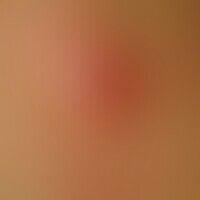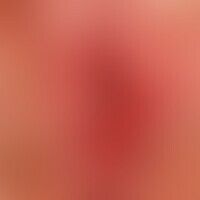Image diagnoses for "Nodule (<1cm)", "red"
191 results with 604 images
Results forNodule (<1cm)red

Basal cell carcinoma (overview) C44.-
Basal cell carcinoma (overview): Nodular, centrally ulcerated basal cell carcinoma.

Tinea barbae B35.0
Tinea barbae. slowly growing, only moderately painful lump that has been present for several months, following multiple surgical procedures.

Primary cutaneous B-cell lymphomas C82- C83
Lymphoma, cutaneous B-cell lymphoma. Chronically active, continuously increasing clinical picture, existing for 6 months. red, blurred, solid, not painful, non-scaling nodular agglomerate consisting of several individual nodes, located on the lateral thorax, with a bumpy surface.

Myiasis (overview) B87.9
Furunculoid myiasisMyiasis: After a stay in the tropics the 25-year-old patient showed a furunculoid nodule with central porus on the left thigh which was only slightly (!) painful.

Lymphomatoids papulose C86.6
Lymphomatoid papulosis: intermittent, painless, papules and nodules with central necrosis and crust formation (nodules above).

Infant haemangioma (overview) D18.01

Keloid (overview) L91.0

Granuloma anulare disseminatum L92.0

Vulvar lichen sclerosus N90.4
Long-standing lichen sclerosus of the vulva with complicated carcinoma development (see following figure); complete atrophy of the small labia.

Acne inversa L73.2
Acne inversa. Severe clinical, refractory findings in a 52-year-old female patient. Present since the age of 20. Perianal involvement here.

Keratoakanthoma (overview) D23.-
Keratoakanthoma, classic type, short term, hard, reddish, hard, reddish, centrally dented, strongly keratinized lump with isolated telangiectasias on the surface, grown within 4 weeks, measuring about 1.5 cm, in a 51-year-old female patient.

Carcinoma of the skin (overview) C44.L
Carcinoma cutanes: advanced, flat ulcerated exophytic squamous cell carcinoma .

Squamous cell carcinoma of the skin C44.-
Squamous cell carcinoma of the skin: slowly growing, painless, broad-based nodule that has been wetting for several weeks.

Acuminate condyloma A63.0
Condylomata gigantea: cauliflower-like, exophytic and locally infiltrating fibroepithelial prollferates in the anal and peerianal region; known HIV infection.

Borrelia lymphocytoma L98.8
Lymphadenosis cutis benigna: soft, reddish-livid, blurred reddish-brownish lump at the edge of the auricle in the child, since 3 months.









